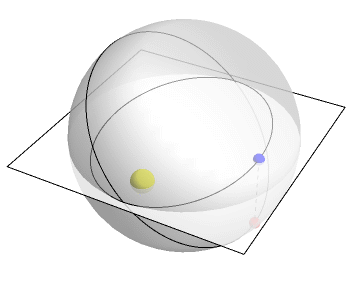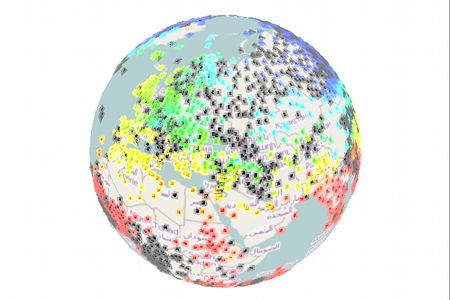John C. Baez's Blog, page 81
March 16, 2015
Planets in the Fourth Dimension
You probably that planets go around the sun in elliptical orbits. But do you know why?
In fact, they’re moving in circles in 4 dimensions. But when these circles are projected down to 3-dimensional space, they become ellipses!
This animation by Greg Egan shows the idea:

The plane here represents 2 of the 3 space dimensions we live in. The vertical direction is the mysterious fourth dimension. The planet goes around in a circle in 4-dimensional space. But down here in 3 dimensions, its ‘sh...
March 13, 2015
Quantum Superposition
guest post by Piotr Migda
In this blog post I will introduce some basics of quantum mechanics, with the emphasis on why a particle being in a few places at once behaves measurably differently from a particle whose position we just don’t know. It’s a kind of continuation of the “Quantum Network Theory” series (Part 1, Part 2) by Tomi Johnson about our work in Jake Biamonte’s group at the ISI Foundation in Turin. My goal is to explain quantum community detection. Before that, I need to introduc...
March 4, 2015
Melting Permafrost (Part 4)

Russian scientists have recently found more new craters in Siberia, apparently formed by explosions of methane. Three were found last summer. They looked for more using satellite photos… and found more!
���What I think is happening here is, the permafrost has been acting as a cap or seal on the ground, through which gas can���t permeate,��� says Paul Overduin, a permafrost expert at the Alfred Wegener Institute in Germany. ���And it reaches a particular temperature where there���s not enough i...
March 1, 2015
Visual Insight
I have another blog called Visual Insight. Over here, my focus is on applying mathematics to help save the planet. Over there, I try to make the beauty of pure mathematics visible to the naked eye.
I’m always looking for great images, so if you know about one, please tell me about it! If not, you may still enjoy taking a look.
Here are three of my favorite images from that blog, and a bit about the people who created them.
I suspect that these images, and many more on Visual Insight, are all jus...
February 19, 2015
Scholz’s Star

100,000 years ago, some of my ancestors came out of Africa and arrived in the Middle East. 50,000 years ago, some of them reached Asia. But between those dates, two stars passed through the outer reaches of the Solar System, where icy comets float in dark space!
One is a tiny red dwarf called Scholz’s star. It’s only 90 times as heavy as Jupiter. Right now it’s 20 light years from us, so faint that it was only discovered in 2013, by Ralf-Dieter Scholz—an expert on nearby stars, high-velocity s...
February 18, 2015
Higher-Dimensional Rewriting in Warsaw

This summer there will be a conference on higher-dimensional algebra and rewrite rules in Warsaw. They want people to submit papers! I’ll give a talk about presentations of symmetric monoidal categories that arise in electrical engineering and control theory. This is part of the network theory program, which we talk about so often here on Azimuth.
There should also be interesting talks about combinatorial algebra, homotopical aspects of rewriting theory, and more:
February 13, 2015
Earth-Like Planets Near Red Dwarf Stars

Can red dwarf stars have Earth-like planets with life?
This is an important question, at least in the long run, because 80% of the stars in the Milky Way are red dwarfs, even though none are visible to the naked eye. 20 of the 30 nearest stars are red dwarfs! It would be nice to know if they can have planets with life.
Also, red dwarf stars live a long time! They’re small—and the smaller a star is, the longer it lives. Calculations show that a red dwarf one-tenth the mass of our Sun should last...
February 9, 2015
Exploring Climate Data (Part 3)
post by Nadja Kutz

This blog article is about the temperature data used in the reports of the Intergovernmental panel on Climate Change (IPCC). I present the results of an investigation into the completeness of global land surface temperature records. There are noticeable gaps in the data records, but I leave discussion about the implications of these gaps to the readers.
The data used in the newest IPCC report, namely the Fifth Assessment Report (AR5) is, as it seems, at the time of writing no...
February 5, 2015
Azimuth News (Part 3)
post by David Tanzer
Here are some notes from the back offices of the Azimuth project. After a long and productive stay as the Azimuth tech guy, Andrew Stacey is moving along and passing the baton to me. As part of this change, we���ve relocated the servers to a new Azimuth hosted account, and updated the forum software.
The forum is now at a new location:
https://forum.azimuthproject.org
This is where we collaborate on writing wiki and blog articles, on research and education projects, and on so...
February 3, 2015
Lebesgue’s Universal Covering Problem (Part 2)
A while back I described a century-old geometry problem posed by the famous French mathematician Lebesgue, inventor of our modern theory of areas and volumes.
This problem is famously difficult. So I’m happy to report some progress:
• John Baez, Karine Bagdasaryan and Philip Gibbs, Lebesgue’s universal covering problem.
But we’d like you to check our work! It will help if you’re good at programming. As far as the math goes, it’s just high-school geometry… carried to a fanatical level of intensit...
John C. Baez's Blog
- John C. Baez's profile
- 29 followers



